List of buildings and structures at Black Creek Pioneer Village
There are over forty 19th-century buildings at Black Creek Pioneer Village, all of which are decorated and furnished according to the styles of the 1860s, some with the building's original furnishings.
Several of the buildings were originally constructed at their current location. The others were relocated from other communities in Ontario.
| Building | Photo | Year of construction | Original location | Architectural style | Relocated | Opened | Notes |
|---|---|---|---|---|---|---|---|
| Apple storage cellar | .jpg.webp) |
c. 1850 | Edgeley | Field stone and brick | 1976 | 1976 | The building was dismantled at its original site and reconstructed at Black Creek Pioneer Village. |
| Bolton Shop | 1865 | Bolton | 1968 | 1973 | Originally used by a merchant tailor. Houses a 19th-century photography studio. | ||
| Broom Maker's Shop | Sherwood | Square log | 1963 | 1973 | May have been first school in Maple. | ||
| Burwick House | .jpg.webp) |
1844 | Woodbridge | Rural Georgian | 13 August 1958 | Front portion moved to site intact; back portion required reconstruction. Furnishings are original with imported Regency style dining room, Chippendale and Sheraton parlour pieces, and locally crafted bedroom and kitchen furniture.[1] | |
| Cemetery | 1845 | Current site | N/A | N/A | N/A | Last interment was in 1927. | |
| Charles Irvine's Weaver's Shop; Printing Office | .jpg.webp) |
1850 | Kettleby | Timber frame | 1968 | 1971 | Constructed as a temperance hall by the Sons of Temperance. Moved intact in 1968. Contains a functional Washington flat bed press, a Gordon press, and a flying shuttle loom. |
| Chicken House | c. 1860 | Kettleby | Round log | 1972 | 1973 | ||
| Church Drive Shed | 1860 | Vaughan | 1982 | Used to provide covered parking for parishioner horses and buggies. Dismantled in the 1970s by the Credit Valley Conservation Authority. | |||
| Daniel Flynn House | 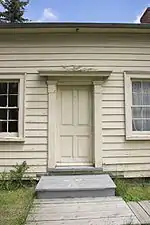 |
1858 | Newtonbrook | Ontario classic style | 1959 | 1960 | |
| Daniel Flynn Boot and Shoe Shop | .jpg.webp) |
1858 | Newtonbrook | 1963 | |||
| Daniel Stong’s First House |  |
1816 | Current site | Squared log | N/A | 1958 | Was used as Stong residence until 1832, then repurposed as an outbuilding. |
| Daniel Stong's Second House | c. 1832 | Current site | Squared log on fieldstone foundation | N/A | 1960 | ||
| Daniel Stong Smokehouse | c. 1820 | Current site | Squared log | N/A | 1960 | Rebuilt in 1965 because of fire. | |
| Daniel Stong Grain Barn | 1825 | Current site | N/A | 1960 | One of the buildings original to the site. | ||
| Dickson Hill School | .jpg.webp) |
1861 | Dickson Hill | 1960 | Typical of the area's one-room schoolhouses of the period. The building was dismantled, moved to its current site, and rebuilt. | ||
| Doctor's House |  |
c. 1830 | Chinquacousy | Timber frame with wood sheathing, stucco finish | 1973 | 1978 | Building had two separate quarters with dedicated entrances, one side used by the family, the other side for the medical practice. This is a re-creation of a doctor's residence.[2] |
| Dominion Carriage Works | .jpg.webp) |
1860 | Sebringville | 1973 | 1976 | Includes original tools and patterns. | |
| Edgeley Rabbit Hutch | .jpg.webp) |
c. 1860 | Edgeley | Timber frame | 1970 | 1971 | Used by local farmer's to butcher animals. |
| Fisherville Church | 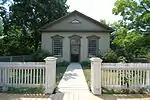 |
1856 | Fisherville | Greek Revival | 1960 | 1962 | |
| Half Way House Inn | .jpg.webp) |
1849 | Scarborough | Georgian | 1966 | Typical of tavern structures common in southern Ontario before Canadian Confederation. The building required extensive restoration, performed based on historical documents and the building's structure. Named because it was located halfway between Dunbarton and the St. Lawrence Market.[3] | |
| Henry Snider's Cider Mill | c. 1940 | Elia | 1959 | 1961 | The mill was used to produce cider for family and friends; it was not used commercially, though it had a screw press with a capacity to make 500 gallons of cider daily.[4] | ||
| Laskay Emporium | 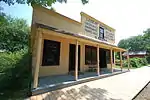 |
1845 | Laskay | Frame with false front | 19 February 1960 | Reconstructed based on historical documents and photographs from 1911. | |
| Limehouse Outhouse | c. 1840 | Limehouse | Neoclassical/Georgian | 1971 | 1972 | ||
| Mackenzie Barn | c. 1850 | Woodbridge | Timber frame on stone foundation | ||||
| Mackenzie House |  |
c. 1830 | Woodbridge | Log cabin | |||
| The Manse | .jpg.webp) |
1835 | Richmond Hill | Neoclassical | 7 October 1978 | Used as manse by reverend of the Richmond Hill Presbyterian Church. Moved to Black Creek Pioneer Village in two pieces. | |
| Mennonite Meeting House | 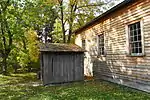 |
1824 | Edgeley | Log building | 15 October 1976 | Contains original furnishings. | |
| Roblin's Mill | .jpg.webp) |
1842 | Ameliasburg | 1964 | Consists of original timbers, flooring, and machinery, except for the 1848 wheel, which was replaced with a smaller version. The building was scheduled for demolition before its acquisition. | ||
| Rose Blacksmith Shop | .jpg.webp) |
c. 1855 | Nobleton | Timber frame, board and batten | 1958 | 1960 | |
| Samuel Stong House | c. 1855 | Vaughan | Log house | ||||
| Snider Workshop | c. 1840 | Concord | 1967 | Originally a second house for the Snider family, later used as a farm workshop. Moved to Black Creek Pioneer Village as a Canadian Centennial project by the Snider family. | |||
| Taylor Cooperage | 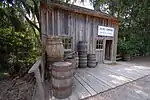 |
c. 1850 | Paris | Timber frame with board and batten | 1976 | 1988 | |
| Tinsmith Shop and Masonic Lodge | .jpg.webp) |
c. 1850 | Woodbridge | 1983 | 1984 | Ground floor was a tinsmith shop, upper floor a Masonic lodge. Donated by the Masons of Ontario.[5] Dismantled, moved, and reconstructed at current site. | |
| Wilmot Township Hall | .jpg.webp) |
1858 | Baden | Timber frame with clapboard siding | 1967 | Housed the Fifth Division Court of the County of Waterloo. |
Notes
- Mika, Mika & Thompson 2000, p. 39—40.
- Connor & Connor 1991, p. 104.
- Mika, Mika & Thompson, p. 48.
- Mika, Mika & Thompson 2000, p. 38.
- Mika, Mika & Thompson 2000, p. 35.
References
- Connor, Jennifer J.; Connor, J.T.H. (1991). "Medical and Related Museums, Historic Sites, and Exhibits in Ontario: An Annotated Guide and Review". Canadian Bulletin of Medical History. Canadian Society for the History of Medicine. 8: 101–119. doi:10.3138/cbmh.8.1.101. ISSN 0823-2105.CS1 maint: ref=harv (link)
- Mika, Nick; Mika, Helma; Thompson, Gary (2000). Black Creek Pioneer Village. Toronto: Natural Heritage books. ISBN 1896219640.CS1 maint: ref=harv (link)
External links
This article is issued from Wikipedia. The text is licensed under Creative Commons - Attribution - Sharealike. Additional terms may apply for the media files.